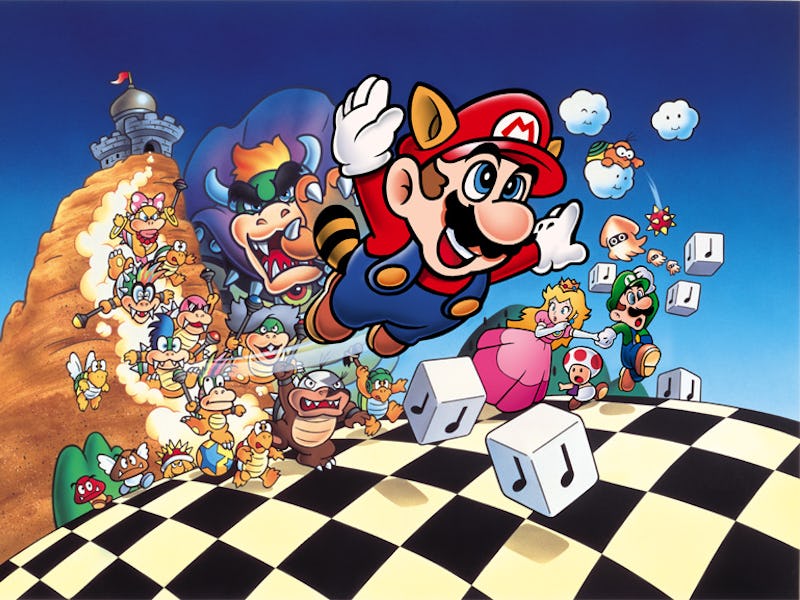You need to play the most important Mario game on Nintendo Switch ASAP
This entry was a huge leap forward for Mario — even though he smashed his head on a block.

Super Mario Bros. 3 changed how the world saw video games.
Its release in 1988 was a bit like when The Beatles released Sgt. Pepper’s Lonely Hearts Club Band in 1967. Super Mario Bros. 3 was massively anticipated in North America and once released in 1990, it somehow managed to exceed the tremendous hype. The game’s financial success alone heralded a new industry that wouldn’t just be a fad, and its innovations in gameplay and design would directly inspire multiple franchises.
It’s little wonder that at the Game Developers Conference of 2007, when a committee of video game historians, designers, and journalists announced their idea of a video game canon, SMB3 made the cut. It’s hard to imagine a canon that wouldn’t include the game.
If you’re a paid Nintendo Switch online subscriber, you can play Super Marios Bros. 3 right now by downloading the Nintendo Entertainment System app.
This title screen is burned into our memories.
Some levels in SMB3 are against solo bosses, and others feel like puzzles laid out across a beautiful background. The game is bursting with variety in its eight worlds, constantly offering something new. Cannonball airships, hammer-throwing turtles, shy Boos, and even the Sun itself comes down to wreak havoc on poor Mario.
That variety comes in terms of pacing as well: Sometimes the game constantly pulls its player between patient pausing and moving at breakneck speeds.
By 1990, when SMB3 was released in North America, Mario had already become a household name. Five years earlier, the original Super Mario Bros. had released in America and created a fervor for side-scrolling games.
SMB3 director Shigeru Miyamoto and programmer Toshihiko Nakago worked together on a side-scrolling racing game called Excitebike. It introduced them to not only each other but also the possibilities of the medium. With its opening level, World 1-1, famous for easing a player into its world, SMB3 quickly caught on with people who had never picked up a controller before.
Iconic.
By the time the third game began development, Mario was becoming a centrifugal force in gaming, something other properties responded to. Metroid’s developers made their main character, Samus, purposefully different from the plumber in the Mushroom Kingdom. Other games filled in spaces where Mario came up short, like in terms of story.
The 11-person development team behind SMB3, led by Miyamoto, Nakago, and co-director Takashi Tezuka, painstakingly sketched out each level of the game by hand. The history of SMB3 is well-documented, and it’s worth checking out an in-depth overview like Gaming Historian’s for all the details. There’s the pressure Nintendo was facing by Sega’s announced 16-bit system to game shortages caused by worldwide chip demands.
But from a development perspective, making the game was an intensive process completed by a team operating at the top of their game.
There’s nothing wasted in SMB3. From the game’s theatrical opening to the set pieces that look bolted on to the backgrounds, there’s a sense that each stage is a play and the player is the lead actor. The game’s music, created solely by Koji Kondo, enhances the atmosphere of every moment, from the delightful fanfare of a completed level to the peppy sounds of Grass Land to the dark and almost militaristic sounds of World Eight.
Mario looking stylish in all of his suits.
As for Mario, he’s given a wide variety of new powers in SMB3, which take the form of various costumes.
There’s the Raccoon Suit of the cover, which gives Mario flying powers, a Frog Suit that lets him move quicker through water but slower on land, a hammer-throwing Hammer Suit, and the Tanooki Suit, which offers the same flying powers as the flying suit with an additional turn-to-stone feature that allows Mario to resist fireballs.
These quirky suits drastically change Mario’s look and allow for further variety in gameplay, while also allowing the game’s designer to show off some of their odder designs. A player looking to power through Goombas with fireballs or hammers might not be interested in a raccoon feather. Similarly, the game allows for a degree of path-choosing, letting players experience levels in the order they want (to an extent). While it’s not as open-world as Starfox, there’s a sense throughout SMB3 that players can build out their own style of gameplay.
One worry that developers had was that the world of SMB3 would be too cute, thus signaling to older players that it wasn’t for them. But there’s something absolutely timeless about these designs, from the spin of the Raccoon Suit to the Boos covering their eyes as the player looks at them. Beyond all the hype surrounding a game regularly hailed as the Greatest of All Time, SMB3 remains what it was at launch: a fun and challenging side-scroller that will keep a player analyzing every inch of the level for an advantage.
This article was originally published on